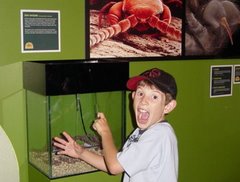Several sessions that looked at case studies at a range of museums. One thing that struck we was the ways that visitors' voices are being incorporated into the physical museum using on-line tools. The Denver Art Museum has a live feed into their foyer with Flickr fotos that visitors have updated. The Art of Storytelling project at the Delaware Art Museum engaged visitors with the art by enabling them to tell their own stories about the works of art and making new works from existing ones. The evaluation showed that those who had participated reported feeling more connected to art in general.
The Living Museum project is an interesting experiment and the lessons learned from their earlier work was quite instructive. They have decided to have a set of guidelines for exhibitions that can be put straight online, such as spelling and grammar, relevance to the actual content (Jewish heritage), clear fotos, complete labels, etc. Challenges: resources, small number of current users, average exhibition is 21 artefacts and they post them up within a week so that people remain engaged. How to help users contribute quality content – constantly convey expectations, email and phone support, consider different user needs, continually review and make recommendations about how users can improve their exhibitions in future.
In Your Face, The People's Portrait Project: invited people to submit portraits with three provisos - original portraits, copyright waiver they sign off, 6x4 inches. With no advertising in 12 months they had over 17,000 submissions! Gave them a very good idea of the audience who is interested in and cares about the AGO. Created a Flickr group also, but still figuring that out regarding copyright, although group has continued. Lessons learned and questions asked:
- How do you balance museum's agenda with visitor expectations?
- Is it possible to assert control and foster programming that is open-ended? Tension between running open-ended programming and standards, expertise and quality
- How do we think about expertise quality and standards?
- How do we integrate and manage creativity in ways that are dynamic and long-term?
Lessons learned:
- Take risks, experiment and be willing to make mistakes
- Museums as catalysts for creativity
- The critical mass of creativity asserts its own kind of aesthetic
- Value in generating user-generated content that is actual as well as virtual
- Ultimately it is about people
- Public invested if programming is authentic and they feel respected
- Buildings and collections only part of the story
Question arose about motivation: why would people want to engage with a museum through user-generated content? People find something that's relevant to them; people become part of a whole and being engaged with each other as well as the museum. For teachers it was that something was missing from their curriculum that the museum could help with.
A really interesting session. Another thing that keeps coming up is the work that museums are doing with Flickr – seems this is a tool that many have found useful (and my post on Flickr and audience research also generated quite a bit of discussion), obviously there's something there. The Powerhouse Museum announced its participation in the Commons on Flickr website, which is something we could be pursuing further I think.



No comments:
Post a Comment